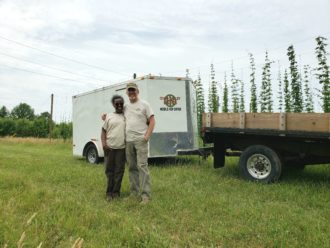In a state that boasts 300 craft breweries, David Volkman is among many craft beer enthusiasts in Ohio. But Volkman, with 12 acres of land in Warren County, is not only supporting Ohio’s craft brewing industry through consumption; he’s also contributing to its production. In 2012, he and his wife, Nina, started transitioning some of their small acreage to grow hops. Today, they grow 1,400 plants on about 1.5 acres and they’ve named their business Ohio Valley Hops. Hops are in demand in Ohio. U.S. hop acreage has increased by 72% since 2012; In Ohio, less than 2% of the hops used to brew a whopping 1.09 million barrels of craft beer are grown locally (Ohio Craft Brewers Association, 2018).
“There was a large demand in Ohio, but no local supply,” said David Volkman. “As a fan of craft brewing, I attended a few field days and we decided to give it a go.”
Volkman says that with improved quality and increasing quantity, growing hops sustainably as an alternate crop can provide additional income for small farmers in Ohio. But hops production requires equipment, from harvesters to hammer mills, from pelletizers to dryers. The Volkmans own a mobile hop harvester and travel throughout the region, offering custom harvesting for other growers. They wondered whether they could add mobile hops drying to the services they were offering to Ohio’s hops growers.
“Drying is something that must happen as soon as possible, on the farm, to maximize quality,” explained Volkman. “Several growers have built fixed drying facilities that allow on-farm drying, which has proven to be effective and efficient. However, they cost several thousand dollars and permanently take up floor space. Practically and financially, not every farm needs to tie up space and money in a dryer. Sharing is viable since drying takes ~48 hours. Ohio’s harvest starts in the southwest in July and continues through September in the northeast, with about a seven to ten-day harvest window per variety. It is practical that numerous growers could use one mobile dryer.”
Determined to make drying hops more efficient, Volkman applied for a $7,500 NCR-SARE Farmer Rancher grant to build a mobile hop dryer that multiple growers could use. He wanted to find a way to quickly dry hops to the ideal moisture content for processing while reducing individual farmer investment by creating a shareable resource.
Using an enclosed trailer, Volkman devised a two-step drying process involving high-volume air movement for initial drying and then lower-volume conditioned air for finishing. He could dry up to 1,000 pounds of hops in 48 hours. Smaller loads took as little as 24 hours. Volkman shared the dryer with four Ohio hops growers the first year; growers picked up the trailer, pulled it to their site, used it, and returned it (or dropped it off for another grower to use). During the second year of his project, he shared the mobile dryer with five growers and determined that even more growers could have been included.
“From many discussions over the last several years, processors’ biggest gripe is that growers do not dry their hops evenly or thoroughly,” explained Volkman. “That was not the case with the mobile dryer. Simply following provided instructions on bin rotation, using heat and air properly, and doing moisture testing led all users to get their hops in the 8-10% moisture range, ideal for further processing and packaging.”
Volkman has shared information about the mobile hops dryer at numerous field days and events and has developed a resource that includes design details.
View Related SARE Grant:
- Mobile Hop Dryer (FNC17-1103)
